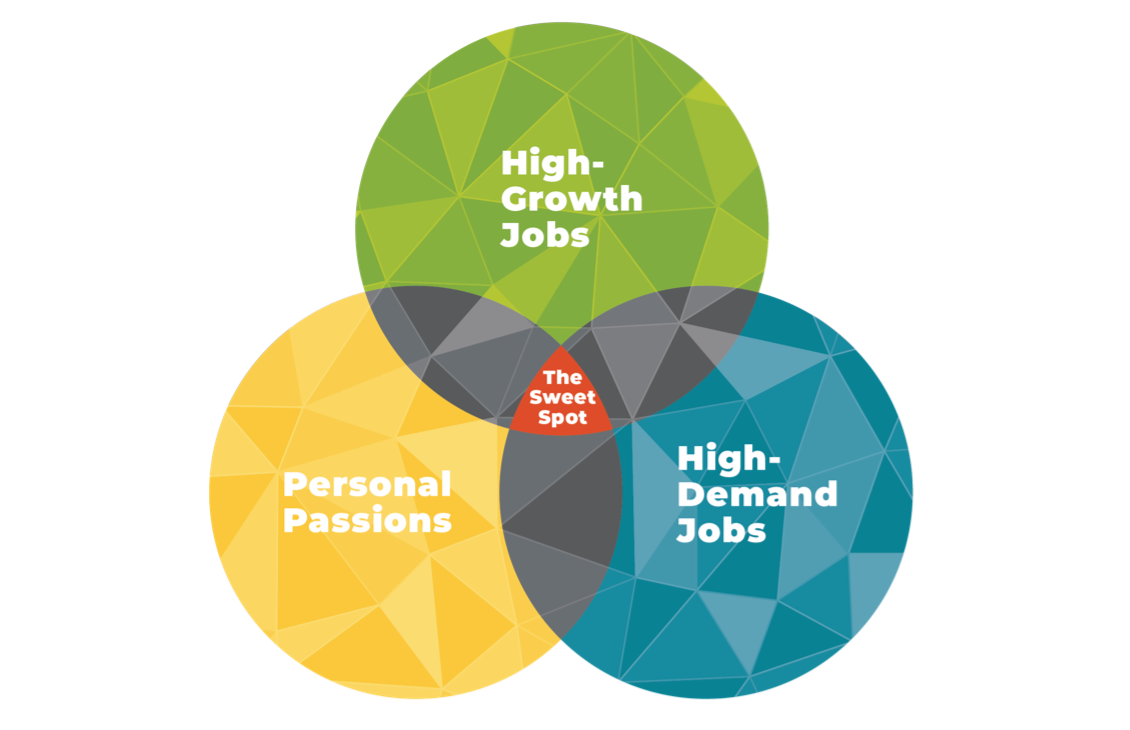Find the Sweet Spot between Personal Passions and Workplace Demands

As a product of Kansas public schools in the 1980s and early 1990s, I grew up believing that if I (as a girl) wanted to be president of the United States, I could be. My parents taught me that if William wants a doll, he should have one, and that it was just as important for women to work outside of the home as men. The economy was booming, women and people of color were finding more success in the workplace, and as children of Baby Boomers, many in my generation were empowered to explore unlimited passions and shoot for their dreams — usually by way of an affordable, four-year university education.
Today, as the mom of a high school senior, it’s very clear that the situation is much more nuanced than I could see as a young, white adult with middle-class parents. One big factor that has impacted access to education and opportunity for everyone is the cost of higher education. In-state tuition, books, fees and housing for colleges and universities in Kansas today cost two to three times what I paid 30 years ago, but personal incomes haven’t grown at nearly the same rate. On top of increased costs, there are fewer opportunities for fully subsidized, low-interest loans and federal grants to make up the difference, leaving many students (and their parents) in significant debt as they begin their careers.
At the same time, workforce shortages have driven up wages in many skilled labor fields. It’s common today for such jobs to come with high starting salaries, strong growth projections, and paid training opportunities. While such careers often require some formal education or certification in addition to a high school diploma, many can be launched with two years or less of post-secondary study — or even paid, on-the-job training or an apprenticeship.
Today, a university education is not the only path young people can pursue to achieve financial independence from their families. As your child’s first career counselor, you can actively help them navigate their many possible paths. Today’s kids need trusted adults to help them strategize what steps after high school they need to take to reach their goals.
Helping Your Child Transition from Student to Employee
If your child is nearing entry into the workforce, think about what their resume will look like. Which skills, certifications and practical experiences do they offer that match what employers need? If the answer is “none,” don’t despair. It’s not too late! Talk to your school’s counselor about opportunities for career and technical education (CTE) courses, internships, job shadowing or other work-based learning opportunities that might give them some real-world skills in high-growth or high-demand fields before they begin making applications. Or, consider attending a technical or community college after high school to gain some in-demand skills before searching for jobs.
If your child is younger, I encourage you to begin career exploration at home together as early as possible, so that your child has years to test out and consider the possibilities — and take advantage of free or low-cost opportunities in high school. Use the Explore Careers section of HirePaths as a starting point for activities and field trips your family can take together to begin helping your child think about their future.
Find the Sweet Spot Between Passions and Employer Needs
As your child’s first career counselor, one thing you can do is help your child research whether a field they’re interested in is expected to have increased employer demand when they’re ready to enter the workforce. For best results, as you help your child think about their many career options, keep this Venn diagram in mind: Identify your child’s passions and interests, learn what jobs are anticipated to be in high-growth and in high-demand in your region, and then narrow your search to look for jobs in that sweet spot where they intersect. That’s where you should invest the time and resources to develop skills that can be nurtured into a lifelong career.

The Explore Careers section of the HirePaths website contains information about many high-demand and high-growth jobs, including median salaries, job growth expectations, recommended educational requirements, and where in Kansas you can get training for these jobs. Once you’ve got some possible job titles in mind, go to the KANSASWORKS database of open positions, enter those titles and where your child wants to live to see how many jobs are available in that profession in the selected area. If you’re finding several open positions, you may have found a strong, realistic career to pursue. Read the full job details to learn more about qualifications needed to apply for such a position down the road.
Good luck and have fun helping your child choose the best path for their future!
Consider These Quickly Growing Fields
In the Explore Careers section of this website, we’ve provided growth forecasts to help users see which jobs are expected to grow, stay steady, or decline in demand over the rest of this decade. While many of these jobs require little to no formal training to get started, most will require some post-secondary schooling, including associate, bachelor’s or even graduate degrees. Pay close attention these career options, because they’re expected to see extreme growth (10% or more) in Kansas over the next decade:
- Aerospace coatings and paint technologist
- Agricultural equipment operator
- Farm worker
- Animal caretaker
- Computer and information systems manager
- Drafter
- Financial manager
- Insurance sales agent
- Landscaping and groundskeeping worker
- Loan officer
- Loan interviewers and clerk
- Market research analysts and marketing specialist
- Medical assistant
- Nursing instructor and teacher
- Occupational therapy assistant and aide
- Personal financial advisor
- Phlebotomist
- Physical therapist
- Physical therapy assistant and aide
- Restaurant cook
- Securities, commodities, and financial services agent
- Veterinary assistant and lab animal caretaker
- Veterinary technologist and technician

Kristin Brighton is a co-owner of New Boston Creative Group, LLC, and the founder of HirePaths. She is the mom of two high school students and a member of the USD 383 school board.



